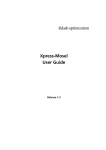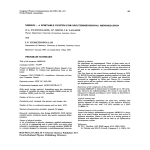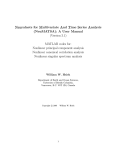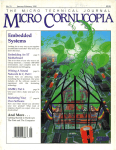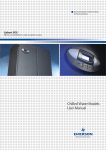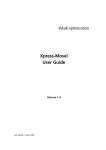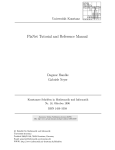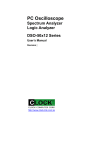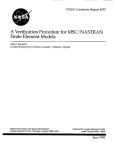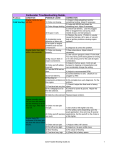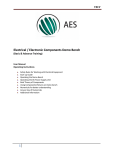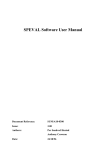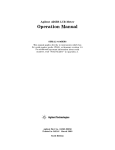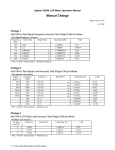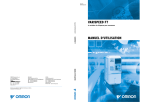Download Feedforward–Backpropagation Neural Net Program ffbp1.0
Transcript
GKSS 2000/37
Feedforward–Backpropagation
Neural Net Program
ffbp1.0
H. Schiller
Feedforward–Backpropagation Neural Net Program
ffbp1.0
Helmut Schiller
Abstract
ffbp1.0 is a C-program for training of feedforward backpropagation neural
nets (NN) running on UNIX computers. The program can be run in batch mode
but also allows user intervention at any time.
A given table can be used as training&test–sample to solve different problems,
like generation of a NN emulating a forward model as well as generation of a NN
emulating its inverse.
NN’s trained with ffbp1.0 are stored in a file. Interfaces to use such NN files
exist for C, MATLAB and pvwave/IDL.
As a byproduct of restricting to multilayer feedforward–backpropagation NN’s
the program is about twice as fast as the Stuttgart Neural Network Simulator
SNNS 3.1.
A zip–file containing all sources, java classes and html–documentation can
be obtained from http://gfesun1.gkss.de/software/ffbp. A README–file explains the installation.
Feedforward–Backpropagation Neuronales Netz Programm ffbp1.0
Abstract
ffbp1.0 ist ein auf UNIX–Rechnern lauffähiges C-Programm zum Training
von (Feedforward Backpropagation) Neuronalen Netzen (NN). Das Programm
arbeitet im Batchmodus, aber der Nutzer kann jederzeit eingreifen.
Eine als Trainings&Test–Sample dienende Tabelle kann zur Lösung verschiedener
Probleme genutzt werden, beispielsweise zur Erzeugung eines NN welches ein
Vorwärtsmodell emuliert oder aber zur Erzeugung eines das inverse Modell emulierenden NN’s.
Mitffbp1.0 trainierte NN’s werden in einem File abgelegt. Die Möglichkeit
der Nutzung solcher NN files besteht für C, MATLAB und pvwave/IDL.
Durch die Einschränkung auf Multilayer Feedforward–Backpropagation NN’s
ist das Program etwa zweimal schneller als der ‘Stuttgart Neural Network Simulator’ SNNS 3.1.
Ein zip–File mit allem Quellcode, Java Klassen und html–Documentation
kann bei http://gfesun1.gkss.de/software/ffbp bezogen werden. Ein README–
File erklärt die Installation.
1
Contents
1 User documentation
1.1 Usage of the program . . . . . . . . . . . . . . . . .
1.2 Preparation of files . . . . . . . . . . . . . . . . . .
1.2.1 Pattern related files . . . . . . . . . . . . . .
1.2.2 The ffbp1.0.start file . . . . . . . . . . .
1.2.3 The ffbp1.0.steer file . . . . . . . . . . .
1.3 Running the program ffbp1.0 . . . . . . . . . . . .
1.3.1 The log files . . . . . . . . . . . . . . . . . .
1.3.2 Communication with the running program .
1.3.3 The .net files . . . . . . . . . . . . . . . . .
1.4 The ff4plot1.0 utility . . . . . . . . . . . . . . . .
1.5 Usage of trained NN (without the ffbp1.0-package)
1.5.1 The C interface . . . . . . . . . . . . . . . .
1.5.2 The MATLAB interface . . . . . . . . . . . . .
1.5.3 The pvwave/IDL interface . . . . . . . . . .
1.6 Summary of program requirements . . . . . . . . .
2 Technical documentation
2.1 Data structures . . . . . . . . . . . . . . . . . .
anchor . . . . . . . . . . . . . . . . . . . . . . .
patterns . . . . . . . . . . . . . . . . . . . . .
parameters . . . . . . . . . . . . . . . . . . . .
feedforward . . . . . . . . . . . . . . . . . . .
backprop . . . . . . . . . . . . . . . . . . . . .
backprop part . . . . . . . . . . . . . . . . . .
2.2 Procedures . . . . . . . . . . . . . . . . . . . . .
ffbp1.0 . . . . . . . . . . . . . . . . . . . . . .
**make vecv(long n, long *s) . . . . . . . .
***make mtxv(long n, long *s) . . . . . . . .
alloc ff(parameters p) . . . . . . . . . . . .
make ff from file(char *filename) . . . . .
alloc bp(feedforward ff) . . . . . . . . . . .
alloc bp part(feedforward ff, feedforward
make anchor() . . . . . . . . . . . . . . . . . .
make patterns(anchor a) . . . . . . . . . . . .
ff ini(feedforward ff, parameters p) . . .
*make defaults(anchor a, patterns p) . . .
ffbp newseq(feedforward ff, backprop bp)
ffbp newseq part(feedforward ff, backprop
ff proc(feedforward ff) . . . . . . . . . . . .
ff to file(feedforward ff, FILE *fp) . . .
5
.
.
.
.
.
.
.
.
.
.
.
.
.
.
.
.
.
.
.
.
.
.
.
.
.
.
.
.
.
.
.
.
.
.
.
.
.
.
.
.
.
.
.
.
.
.
.
.
.
.
.
.
.
.
.
.
.
.
.
.
.
.
.
.
.
.
.
.
.
.
.
.
.
.
.
.
.
.
.
.
.
.
.
.
.
.
.
.
.
.
.
.
.
.
.
.
.
.
.
.
.
.
.
.
.
7
7
8
8
9
10
11
11
11
12
14
14
14
15
16
18
. . . . . . .
. . . . . . .
. . . . . . .
. . . . . . .
. . . . . . .
. . . . . . .
. . . . . . .
. . . . . . .
. . . . . . .
. . . . . . .
. . . . . . .
. . . . . . .
. . . . . . .
. . . . . . .
old) . . .
. . . . . . .
. . . . . . .
. . . . . . .
. . . . . . .
. . . . . . .
part bpp)
. . . . . . .
. . . . . . .
.
.
.
.
.
.
.
.
.
.
.
.
.
.
.
.
.
.
.
.
.
.
.
.
.
.
.
.
.
.
.
.
.
.
.
.
.
.
.
.
.
.
.
.
.
.
.
.
.
.
.
.
.
.
.
.
.
.
.
.
.
.
.
.
.
.
.
.
.
.
.
.
.
.
.
.
.
.
.
.
.
.
.
.
.
.
.
.
.
.
.
.
.
.
.
.
.
.
.
.
.
.
.
.
.
.
.
.
.
.
.
.
.
.
.
.
.
.
.
.
.
.
.
.
.
.
.
.
.
.
.
.
.
.
.
.
.
.
19
19
19
19
20
20
21
21
21
21
21
21
21
22
22
22
22
22
23
23
23
23
23
23
.
.
.
.
.
.
.
.
.
.
.
.
.
.
.
.
.
.
.
.
.
.
.
.
.
.
.
.
.
.
.
.
.
.
.
.
.
.
.
.
.
.
.
.
.
.
.
.
.
.
.
.
.
.
.
.
.
.
.
.
2.3
ff save(anchor a, feedforward ff, patterns p) . . . . . . . . . .
ff error(feedforward ff, double **in, double **out, long np)
*ff gen name(feedforward ff, double error) . . . . . . . . . . . .
ff put into(feedforward from, feedforward to) . . . . . . . . . .
ffbp report(feedforward ff, patterns p, long nc, boolean b) .
bp proc(feedforward ff, backprop bp, parameters p) . . . . . . .
bp proc part(feedforward ff,backprop part bpp,parameters p) .
Utilities . . . . . . . . . . . . . . . . . . . . . . . . . . . . . . . . . . .
myallocs.c . . . . . . . . . . . . . . . . . . . . . . . . . . . . . . . . .
make alphatab() . . . . . . . . . . . . . . . . . . . . . . . . . . . . . .
prep shufind(anchor a, patterns p) . . . . . . . . . . . . . . . . .
make shufind(anchor a, patterns p) . . . . . . . . . . . . . . . . .
get pars(parameters *p) . . . . . . . . . . . . . . . . . . . . . . . . .
get user cmd() . . . . . . . . . . . . . . . . . . . . . . . . . . . . . . .
new steer file(anchor a, feedforward ff, patterns p) . . . . .
scp(double *x, double *y, long n) . . . . . . . . . . . . . . . . . .
6
23
24
24
24
25
25
25
25
25
25
25
26
26
26
26
26
1
User documentation
ffbp1.0 is a C-program for training of feedforward backpropagation neural nets (NN)
running on UNIX computers. The learning function implemented is the gradient descent
algorithm with momentum term as descibed in many text books, e.g. [Bishop 1996].
The program meets the following design goals:
• user interaction with the program can be started from any terminal which has
access to the computer (start the program in the institute and interact from
home). If the terminal allows for XWindows a java program supplies a graphical
user interface (GUI) for user intervention.
• the program can be run with no user interaction at all
• only one pattern file is needed for training and testing. Which points (= lines of
the pattern file) are used for training and testing, respectively, is fixed in a .dscp
file.
• the pattern file is organized by named columns (each column giving one variable).
Which variables are used for input to the net and output from the net, respectively,
is fixed in a .usage file. Therefor the same pattern file can be used to e.g. create
a net for the forward and a net for the inverse model or to create different versions
of an inverse model specifying different subsets of the variables in the respective
.usage file.
• allow for starting with a small net which can be enlarged later if necessary, i.e.
the number of neurons in hidden layers can be increased as well as the number of
hidden layers.
As a byproduct of restricting the program to multilayer feedforward backpropagation
neural nets the program is about twice as fast compared with the Stuttgart Neural
Network Simulator SNNS 3.1 [SNNS 1995].
1.1
Usage of the program
For each problem an extra directory has to be used (let it be myproblem1). The term
‘problem’ here summarizes all the nets derived from a fixed data set and using the same
columns of the data set for net input/output.In myproblem1 two subdirectories have to
be created: nets (where the NN’s are stored) and msg (used for user interference). In
myproblem1 one should have the following programs:
expand dscp to generate from a basic description of the data set a complete one as
needed for the given data set.
ffbp1.0 to create and train the NN’s for the problem.
7
ff4plot1.0 which can be used to calculate NN output for a given net from the test
sample
java classes which establish a graphical user interface to ffbp1.0.
1.2
Preparation of files
In this subsection the necessary input files are described. All input files are expected
in the directory myproblem1.
1.2.1
Pattern related files
The pattern file is expected to have the .patt extension. Each point (=pattern) has
the same number of variables and is stored as a line in the .patt file. The name of
this file is used as the name of the ‘problem’ (let it be probl1). The user then has to
generate two files: probl1.dscp and probl1.usage.
probl1.dscp
gives the names of the variables in the pattern file followed by a line containing
‘end’:
var-name1
var-name2
...
...
var-namek
end
The description file is completed by running the program expand dscp:
expand dscp probl1 ntrain
where ntrain is the number of patterns which will be used for training. As the
selection of points for training (the remaining patterns go to the test sample) is
done randomly this number ntrain is only met approximately.
probl1.usage
gives the information about the variables used for NN input and output, respectively. The names of the variables refer to those given in the .dscp file:
in (number of input neurons)
var-name i1
8
var-name i2
...
var-name iin
out (number of output neurons)
var-name o1
var-name o2
...
var-name oout
1.2.2
The ffbp1.0.start file
The file ffbp1.0.start contains general informations which concern the whole problem
and the NN architecture at the program start:
ffbp1.0.start contains
name of the problem
ns nc
errlim
first net
The values ns, nc concern the so called shuffling. Shuffling means that the order in
which the patterns are presented to the net during the training changes from iteration
to iteration. Since the generation of a random index list is rather time consuming in
ffbp1.0 a fixed number ns of such random index arrays is generated and used for nc
iterations (then new arrays are generated). The actual index array for each iteration is
choosen randomly from the ns arrays.
The errlim is a lower limit of the error function at which the training will stop.
The specification of a net like first net needs only information about the hidden
planes (as NN input/output is fixed for a given problem by definition). The convention
is to indicate the NN size in the following format:
h1xh2x...xhk
where we have k hidden planes with hi neurons in the i–th hidden plane (for a NN
with only one hidden plane no x is given).
ffbp1.0.start Example:
9
probl1
100 50000
1.e-8
30x10
1.2.3
The ffbp1.0.steer file
Before ffbp1.0 is started a last file has to be prepared: ffbp1.0.steer. It contains
commands steering the run (the file must exist, but it could be empty: then the default
parameters are used). The commands are supplied in a line oriented fashion: each
line starts with a letter indicating the command followed by up to two parameters.
Commands are read until iterations (i or j) are asked for. Then the parameters read
so far are used for these iterations. If the iterations are done the next portion of the
ffbp1.0.steer file is read. The order of commands within one such portion does not
matter: the order in which they will be applied by the program is fixed (see below). If
the file is exhausted the program goes into the wait state (p command is executed).
The valid commands are:
letter
command
b
e
i
j
l
m
p
q
r
s
t
v
w
x
parameter(s)
b low b high
size
# iterations
# iterations
learn rate
momentum
name.net
threshold
k
w low w high
neglerr
comment
Biases are generated in [b low,b high]
enlarge the net to size
Learn all net parameters
Learn only new net parameters
Pause, wait for user
Quit
Restart from net in name.net
Save actual net
Save actual net if
error lt threshold*error last saved
print to ffbp1.0.loge file every k iterations
Weights are generated in [w low,w high]
Neglect errors less then neglerr
The commands (if given) are executed in the order s q r e p i|j with parameters (if applicable) as supplied by the commands or from defaults. The default values are
10
command
b
i
l
m
t
v
w
x
parameter(s)
-1 1
1000
0.6
0.2
0.8
100
-1 1
0
So with one portion of the steer file one can e.g. save the last net, enlarge this one
or an old one, initialize its new net parameters and then iteratively change all or only
the new net parameters.
1.3
Running the program ffbp1.0
If started first time the program changes the permissions for the .patt, .usage,
.dscp, .start–files to ‘read only’, to assure the consistency of these files. Also two
log files are created, to which output of later runs is appended.
1.3.1
The log files
There are two log–files which are flushed after each printing so they exhibit always the
most recent state.
ffbp1.0.loge contains pairs of iteration-number and error. The iteration number
refers to the respective program run. The error is derived from a pass through
the training sample with all learning parameters set to zero. The error given is the
sum over the training sample of the sum over the output neurons of the squared
error divided by the number of output neurons and by the number of points in
the training sample.
ffbp1.0.logmsg records all parameter changes, names of saved net files etc.
1.3.2
Communication with the running program
The file working exists during the program run in the directory msg. There also the file
old is created at the program start. These two files are the basis for the user↔program
11
communication. The communication can either be performed ‘by hand’ or through a
graphical user interface.
Communication ‘by hand’
If the user renames the old file
mv msg/old msg/halt
the program will pause after the current iteration is finished and the user can examine the log files (the last line of ffbp1.0.logmsg should read ‘user interferes’).
Now the user can decide either to continue the run
mv msg/halt msg/cont
or to create a new steer file ffbp1.0.steer and supply it by
mv msg/halt msg/new
The program renames this file again to old and the next communication can start.
If the program runs into a p command or exhausts the ffbp1.0.steer file the
last line in ffbp1.0.logmsg will read ‘waiting for user commands’. Then the
program can be halted
mv msg/old msg/halt
and be given a new ffbp1.0.steer file.
Communication by graphical user interface (GUI)
To ease the communication with the program and the inspection of the log files
as well as the creation of new steer files a GUI relying on java was built. Like
the communication ‘by hand’ it can start at any time
java Ffbp1v0 ap
which, if java is included in the shell variable PATH, will lead to a window like
shown in fig. 1.
If the GUI was not started from the problem-directory using File->Open one can
change to the problem directory by selecting any file therein. Help->Explain gives
a window which helps to prepare the steer file. The examine button displays the
log files. The halt ffbp button becomes disabled when pressed and the possible
further choices become enabled.
The GUI informs the user by dialog windows which can be closed by a mouse
click into them.
1.3.3
The .net files
The actual net is saved
• if a s command is met,
• if the program is halted ,
12
Figure 1: The GUI for ffbp1.0
• before quitting.
The name of the netfile is combined from the netsize and the error (here error is the
total error neither divided by the size of the training sample nor by the number of
output neurons). The extension is .net.
The .net files have three sections:
1. general information for the user (see page 23):
• the complete path and name of the problem,
• the date of generation,
• errors from the training and test sample, respectively and
• the names and ranges of the variables which are input/output.
2. starting with ’#’ informations about the ranges from which the variables are
[0,1]-transformed when supplied to the net
3. starting with ’$’ informations about the structure of the net and the values of the
biases and weights. This is the only section used when restarting a problem with
ffbp1.0. The structure of this section can be understood from the code shown
at page 24.
The last two sections are read by programs which use the trained NN for their respective purpose.
13
1.4
The ff4plot1.0 utility
When the final goal of the exercise – a low error function of the trained net – is met one
will be interested to compare in the test sample NN output with the prescribed values.
For this one can with
ff4plot1.0 netfile plotdata
generate a plotdata file with one line for each point of the test sample. The first
values in a line are the NN input. Then for each output neuron a pair (NN output,
true (= prescribed) value) follows. The plotdata file can be used to visualize the
NN performance (already during NN training) like in fig. 2 using any available plot
program.
Figure 2: Visualization of ff4plot1.0 output
1.5
Usage of trained NN (without the ffbp1.0-package)
At the time being there are C, MATLAB and pvwave/IDL interfaces to use NN’s generated with ffbp1.0. To write a new interface one should consult the description of
ff save at page 23.
1.5.1
The C interface
The use of a trained NN is accomplished by the two C–functions ff work prepare and
ff work which should be used as follows:
14
long
*size;
..initialization
size=ff_work_prepare(net_file_name);
/* size[0]=# of NN inputs, size[1]=# of NN outputs */
while(more_points_to_process) {
..
/* we stored the NN input in the double array nn_in
and are ready to feed it forward through the NN */
ff_work(nn_in, nn_out);
/* now the NN output is stored in the
double array nn_out */
..
}
A complete example ff work scheme.c of a program using these two functions can
be found in the zip distribution file. The following commands could be used to compile
and run this program:
cc -xO5 ff_work_scheme.c ff_work.o -o ff_work_scheme -lm
ff_work_scheme 50x12_652.1.net mcrunshort.patt 50x12_652.1.res
textedit 50x12_652.1.res
1.5.2
The MATLAB interface
For MATLAB the class nnhs interfaces to NN’s generated with ffbp1.0, therefor the
following M–files must be put into the (new) directory @nnhs:
nnhs.m: nn = nnhs(ffbp file) is the ’feedforward neural net’ class constructor
(from ffbp1.0 .net file),
char.m: s = char(nn) converts nn to char,
display.m: display(nn) does the command window display of neural net nn,
in nnhs.m: [in, inrange] = in nnhs(nn) returns the number of input neurons and
their ranges,
out nnhs.m: [out, outrange] = out nnhs(nn) returns the number of output neurons and their ranges,
15
ff nnhs.m: out = ff nnhs(nn, in) does the evaluation of neural net response.
The demo program
mynn=nnhs(’10_0.2.net’);
% the NN ’10_0.2.net’ has two input and one output neuron
[x, y]=meshgrid(-4:.16:4);
z=zeros(51,51);
for l=1:51
for m=1:51
z(l,m)=ff_nnhs(mynn, [x(l,m) y(l,m)]);
end
end
meshc(x, y, z);
produces the output shown in fig. 3.
15
10
5
0
4
4
2
2
0
0
−2
−2
−4
−4
Figure 3: ffbp1.0 NN used in above MATLAB program
1.5.3
The pvwave/IDL interface
Here the NN calculations are done by the process calc2 NN, which communicates via
stdio with the mother process. calc2 NN is initialized with the name of the NN and
responds with the number of input and output neurons of the given NN. Then in an
endless loop it accepts inputs to the NN and responds with the resulting output values.
The following example can be used to develop programs using NN’s:
pro calc2_NN
common calc2_NN, NNlun, NN_input, NN_output
writeu, NNlun, NN_input
readu, NNlun, NN_output
end
pro demo_calc2_NN
common calc2_NN, NNlun, NN_input, NN_output; communicate with calc2_NN
16
NN_name=’10_0.2.net’; which net to use
SPAWN, [’calc2_NN’, NN_name], Unit = NNlun, /Noshell; start the program
NN_in =0L; the C-program needs long’s
NN_out=0L
readu, NNlun, NN_in
readu, NNlun, NN_out
print, NN_name,’ has ’,NN_in,’ input and ’,NN_out,’ output neurons’
NN_input=dblarr(NN_in); must be double
NN_output=dblarr(NN_out); must be double
nx=51; now we can use the NN
ny=51
x=8.*dindgen(nx)/(nx-1)-4.
y=8.*dindgen(ny)/(ny-1)-4.
z=dblarr(nx,ny)
for i=0, nx-1 do begin
for j=0, ny-1 do begin
NN_input(0)=x(i)
NN_input(1)=y(j)
calc2_NN;
here we use the NN
z(i,j)=NN_output(0)
endfor
endfor
free_lun, NNlun; we dont need the NN anymore
surface,z,x,y,xtitle=’r!d1!n’,ytitle=’r!d2!n’,ztitle=’c’,$
title=’err1 ’+NN_name,charsize=2.5
return
end
which gives the result shown in fig. 4.
Figure 4: ffbp1.0 NN used in above pvwave program
17
1.6
Summary of program requirements
The following overview summarizes the program requirements:
dir myproblem1
input files to be prepared:
• The pattern file, e.g. probl1.patt, generated by a model run or from
empirical data; to be used as training/test sample for the NN generation.
• The description file, e.g. probl1.dscp, with the names of the variables
in the pattern file. This file must be completed using expand dscp.
• The usage file, e.g. probl1.usage, defining the NN I/O.
• The ffbp1.0.start file containing informations about the whole problem and the NN architecture at the program start.
• The ffbp1.0.steer file with ffbp1.0 commands to steer the NN training.
output files to be inspected during NN training:
• The file ffbp1.0.loge contains pairs of iteration-number and error.
• The file ffbp1.0.logmsg records all all changes of command parameters,
names of saved net files etc..
dir msg contains the files necessary to steer the user ↔ program communication
• ’by hand’ or
• using the java based GUI
⇑
ffbp1.0.steer
⇑
ffbp1.0.loge
⇑
ffbp1.0.logmsg
dir nets contains the NN’s saved during NN training
• which can be used during NN training to visualize the NN performance.
• the final NN can be used by C, MATLAB, pvwave/IDL programs for respective purpose.
18
2
Technical documentation
This section has the following three subsections: the first explains the data structures,
the second gives details about the NN specific functions and in the third subsection
functions of general interest are explained.
2.1
Data structures
The data structures are declared in ffbpnn.h
anchor
essentially stores the stuff from the ffbp1.0.start file
typedef struct {
char
char
boolean
long
long
long
long
*problem;
*pwd;
newproblem;
nhidden;
*hsize;
n_shuffle;
new_shuffle;
double
}
/* name of the problem
/* working directory
errlim;
*/
*/
/* #of hidden pl. of the net
in .start*/
/* and their sizes */
/* #of shuffle index arrays
*/
/* #of cycl until new shuffleind
are made */
/* lower limit, program stops
if reached */
anchor;
patterns
contains informations about the training and test samples
typedef struct {
long
long
char
double
double
npatterns;
nvars;
**varname;
*min;
*max;
/*
/*
/*
/*
/*
#of patterns in .patt-file
#of variables in .patt-file
the names of the variables
their minimum values */
their maximum values */
/* tr_in, tr_out, te_in, te_out: [pattern][variable]
*/
*/
*/
*/
long
double
double
ntrain;
**tr_in;
**tr_out;
/* #of patterns for training
*/
/* training input to net
*/
/* desired net output for tr_in */
long
double
double
ntest;
**te_in;
**te_out;
/* #of patterns for test
*/
/* test input to net
*/
/* desired net output for te_in */
long
long
nnin;
nnout;
/* #of input neurons
/* #of output neurons
19
*/
*/
long
*index_in;
long
*index_out;
}
/* indexes of net input values
wrt .patt file */
/* indexes of net output values
wrt .patt file */
patterns;
parameters
are set by the last read portion of the ffbp1.0.steer file. ‘portion’ means commands until an i or j command is issued
typedef struct {
double
double
double
double
double
double
double
double
double
long
long
long
long
boolean
boolean
boolean
boolean
boolean
boolean
char
}
learn;
momentum;
flatspot;
neglect;
/*
/*
/*
/*
learning rate */
momentum of last change */
added to derivativ
*/
errors with fabs() less then
neglect dont matter */
biasl;
/* next new biases will be gene-*/
biash;
/* rated in [biasl,biash]
*/
wgtl;
/* next new weights will be gene-*/
wgth;
/* rated in [wgtl,wgth]
*/
threshold;
/* save if threshold*last_save_err
gt error */
silence;
/* error reporting every
silence iteration*/
iter;
/* #of iterations to be performed */
nplanes;
/* #of planes in new net
*/
*plsize;
/* their sizes */
save;
/* save command issued */
newsize;
/* new net size is specified
*/
all;
/* true if all parameters
to be iterated */
restart;
/* start from stored net
*/
ready;
/* quit command issued */
wait;
/* p command or .steer
file exhausted */
netfile[256];
/* name of net file for restart */
parameters;
/*from last .steer file portion */
feedforward
is the actual net feeding forward an input pattern
typedef struct {
long
long
double
double
double
double
double
nplanes;
*size;
***wgt;
/* #of planes in net
*/
/* their sizes */
/* weight
[plane][to_neuron][from_neuron] */
/* [plane-1][neuron]
*/
/* neuron output[plane][neuron] */
/* input[neuron]=act[0][neuron] */
/* output[neuron]=
act[nplanes-1][neuron] */
**bias;
**act;
*input;
*output;
20
}
feedforward;
backprop
is the actual net (minus feedforward) backpropagating the errors of an net output
and changing all biases and weights
typedef struct {
double
double
double
**ldbias;
***ldwgt;
**delta;
double
}
/* last changes of **bias
*/
/* last changes of ***wgt
*/
/* [pl][neuron], pl=0..nplanes-2,
backprop. error */
/* errors[neuron] in output layer */
*error;
backprop;
backprop part
is the actual net (minus feedforward) backpropagating the errors of an net output
and changing biases and weights which did not exist before the enlargement of
the net
typedef struct {
double
double
double
**ldbias;
***ldwgt;
**delta;
double
long
}
2.2
/* last changes of **bias
*/
/* last changes of ***wgt
*/
/* [pl][neuron], pl=0..nplanes-2,
backprop. error */
/* errors[neuron] in output layer */
/* sizes of planes
before enlargement */
*error;
*old_size;
backprop_part;
Procedures
ffbp1.0
is the main program
double **make vecv(long n, long *s)
generates a vector [i = 0, . . . n − 1] of n vectors of sizes s[i] as needed for the
biases.
double ***make mtxv(long n, long *s)
generates a vector [i = 0, ..n − 2] of matrices of sizes [s[i + 1], s[i]] as needed for
the weights connecting the layers.
feedforward alloc ff(parameters p)
generates feedforward as described in parameters to describe a feedforward NN.
21
feedforward make ff from file(char *filename)
reads a feedforward NN description from the file filename.
backprop alloc bp(feedforward ff)
generates what in addition to ff is necessary to implement the backpropagation
of errors and the adaption of the parameters of the NN.
back prop part alloc bp part(feedforward ff, feedforward old)
generates what in addition to ff is necessary to implement the backpropagation
of errors and the adaption of the parameters of the NN which were not existing
in the old NN.
anchor make anchor()
• creates the files msg/working and msg/old for user communication,
• reads the file ffbp1.0.start,
• opens the files
pointer
fpsteer
fploge
fplogmsg
fppattv
fppdscp
fppusage
filename
ffbp1.0.steer
ffbp1.0.loge
ffbp1.0.logmsg
problem.patt
problem.dscp
problem.usage
content
commands steering ffbp1.0
iteration# error
,
protocol
patterns
description of patterns
usage of patterns
• changes the permissions of the files ffbp1.0.start, problem.patt, problem.dscp, problem.usage to read only.
patterns make patterns(anchor a)
• allocates space for the parts of the patterns to be used for NN input/output
(training+testing),
• stores the (0, 1)–scaled ntrain NN input vectors of length nnin
to tr in[ntrain][nnin],
• stores the (0, 1)–scaled ntrain NN output vectors of length nnout
to tr out[ntrain][nnout],
• stores the (0, 1)–scaled ntest NN input vectors of length nnin to
te in[ntest][nnin],
• stores the (0, 1)–scaled ntest NN output vectors of length nnout
to te out[ntest][nnout],
• closes fppattv, fppusage, fppdscp.
22
void ff ini(feedforward ff, parameters p)
initializes the weights and biases of the ff NN in ranges given in parameters.
parameters *make defaults(anchor a, patterns p)
• puts default values for parameters which can be changed with commands in
the ffbp1.0.steer file,
• takes the net size given in ffbp1.0.start as default.
void ffbp newseq(feedforward ff, backprop bp)
zeroes the fields with the last changes of biases and weights, which are used to
store the values for the momentum term.
void ffbp newseq part(feedforward ff, backprop part bpp)
zeroes the fields with the last changes of new biases and new weights, which are
used to store the values for the momentum term.
void ff proc(feedforward ff)
processes the given NN input through the NN to produce the corresponding NN
output.
void ff to file(feedforward ff, FILE *fp)
writes the NN ff to file *fp.
void ff save(anchor a, feedforward ff, patterns p)
saves the NN ff to a file. The name of the file is given by ff gen name. The file
contains helpful informations like:
problem: /export/home/schiller/progs/c/nnhs/nnhs2/mcrunst
saved at Fri Aug 8 05:24:24 1997
trainings sample has total sum of error^2=696.980276
average of residues:
training 696.980276/45802/11=0.005072 test 173.181012/11438/3=0.005047
ratio avg.train/avg.test=1.005046
the net has
input 1 is
input 2 is
input 3 is
input 4 is
input 5 is
input 6 is
input 7 is
input 8 is
input 9 is
input 10 is
input 11 is
11 inputs:
sun_theta in [0.000574,1.309000]
view_theta in [0.000000,0.715600]
view_phi in [0.000141,3.142000]
refl1 in [0.000052,0.172700]
refl2 in [0.000061,0.178200]
refl3 in [0.000076,0.159300]
refl4 in [0.000086,0.124200]
refl5 in [0.000108,0.084930]
refl6 in [0.000068,0.025000]
refl7 in [0.000049,0.016750]
refl8 in [0.000023,0.008868]
23
the net
output
output
output
has 3 outputs:
1 is log_conc_phy in [-5.807000,3.909000]
2 is log_conc_gelb in [-6.214000,0.693100]
3 is log_conc_min in [-3.506000,3.912000]
For later usage of the stored NN after ‘#’ the number of input neurons and their
ranges of input values are given followed by the number of output neurons and
their ranges of output values, respectively. After a ‘$’ the parameters of the
actual NN follow. The structure of this part is seen from the following piece of
code which writes the parameters:
fprintf(fp, "$\n#planes=%ld", ff.nplanes);
for (pl = 0; pl < ff.nplanes; pl++)
fprintf(fp, " %ld", ff.size[pl]);
fprintf(fp, "\n");
for (pl = 0; pl < ff.nplanes - 1; pl++) {
fprintf(fp, "bias %ld %ld\n", pl + 1, ff.size[pl + 1]);
for (i = 0; i < ff.size[pl + 1]; i++)
fprintf(fp, "%lf\n", ff.bias[pl][i]);
}
for (pl = 0; pl < ff.nplanes - 1; pl++) {
fprintf(fp, "wgt %ld %ld %ld\n",
pl, ff.size[pl], ff.size[pl + 1]);
for (i = 0; i < ff.size[pl + 1]; i++) {
for (j = 0; j < ff.size[pl]; j++)
fprintf(fp, "%lf\n",ff.wgt[pl][i][j]);
}
}
double ff error(feedforward ff, double **in, double **out, long npatt)
calculates the total sum of squared errors produced by ff if given the npatt NN
inputs in[npatt][nnin] and prescribed outputs out[npatt][nnout].
char *ff gen name(feedforward ff, double error)
generates a name for the file to which the actual NN ff is to be saved. The name
is built by concatenating the NN size with the error:
30x10 244.5.net
is the name of the file into which the NN of size 30x10 producing an error 244.5
(using the training sample) will be saved.
void ff put into(feedforward from, feedforward to)
copies the biases and weights from the (smaller) NN from to the (larger) NN to.
(The remaining new biases and weights have are initialized.)
24
void ffbp report(feedforward ff, patterns p, long nc, boolean both)
reports to the file ff1.0.logmsg at iteration nc about the net performance. both
has to be TRUE if not only the performance of the NN with the training sample
but also with the test sample is to be reported.
void ff info(feedforward ff, FILE *fp)
writes the plane sizes of NN ff to *fp.
void bp proc(feedforward ff, backprop bp, parameters p)
does for a given pattern which was fed forward by ff proc the backpropagation
of the error and the corresponding change of all the biases and all the weights and
stores those changes so they can be used in the momentum term.
void bp proc part(feedforward ff, backprop part bpp, parameters p)
does for a given pattern which was processed forward by ff proc the backpropagation of the error and the corresponding change of the new biases and the new
weights and stores those changes so they can be used in the momentum term.
2.3
Utilities
myallocs.c
contains a set of space allocating functions which chose myexit() (removing
msg/working) in case of failure:
X alloc(long n) returns space
X=
for n
mc
char
mcp
char *
l
long
lp
long *
d
double
dp
double *
dpp
double **
void make alphatab()
generates N ALPHA entries in alpha tab[N ALPHA] tabulating the logistic function in the range (ALPHA ANF,-ALPHA ANF) being used by alpha(x) which does
the actual interpolation.
void prep shufind(anchor a, patterns p)
allocates space for n shuffle index vectors to shuffle the ntrain patterns.
25
void make shufind(anchor a, patterns p)
fills the shuffle[n shuffle][ntrain] index vectors with a random permutation
of (0, 1, . . . , ntrain − 1) to shuffle through the ntrain training patterns.
void get pars(parameters *p)
reads commands from ffbp1.0.steer and sets parameters accordingly.
void par info(parameters p, long cyc, FILE *fp)
writes at iteration cyc the actual parameters p to *fp.
enum user cmd get user cmd()
waits for user intervention and returns new or cont if the user renames msg/halt
to msg/new or msg/cont, respectively.
boolean new steer file(anchor a, feedforward ff, patterns p)
checks if the user renamed msg/old to msg/halt and returns FALSE immediately
if the user did not rename. Otherwise it waits until user intervention is ready and
returns TRUE if the user supplied a new steering file ffbp1.0.steer.
double scp(double *x, double *y, long n)
calculates the scalar product of x[n]*y[n].
References
[SNNS 1995]
SNNS, Stuttgart Neural Network Simulator, User Manual,
Version 3.1, University of Stuttgart, Institute for parallel
and distributed high performance systems (anonymous ftp
ftp.informatik.uni-stuttgart.de (129.69.211.2)).
[Bishop 1996]
Bishop, Chris; Neural networks for pattern recognition; Oxford University Press, New York; 1996.
26

























